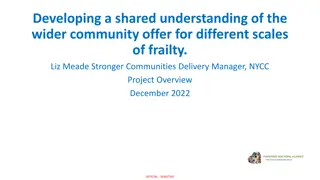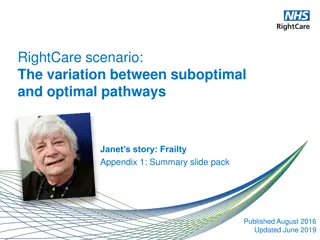National Frailty Approach in Later Life Healthcare
Exploring the significance of frailty in an ageing population, this presentation discusses key principles, the impact of frailty on healthcare outcomes, and the need for proactive frailty identification and management. It emphasizes the growing challenges posed by an ageing population and highlights the economic implications and workforce development required to address frailty effectively.
Download Presentation

Please find below an Image/Link to download the presentation.
The content on the website is provided AS IS for your information and personal use only. It may not be sold, licensed, or shared on other websites without obtaining consent from the author. Download presentation by click this link. If you encounter any issues during the download, it is possible that the publisher has removed the file from their server.
E N D
Presentation Transcript
Ageing Well Quality Healthcare in Later Life National Frailty Approach Dawn Moody Associate National Clinical Director Older People 27th April 2018 North Region, Leeds www.england.nhs.uk 1
What I am going to discuss Key Principles Why frailty matters Frailty identification Managing frailty as a long term condition People, populations and communities National Approach GP Contract Research and Innovation Frailty Economic Modeling Rightcare & GIRFT Workforce development www.england.nhs.uk
Why is frailty important? Population ageing 2015-2025 Number of people age 65+ will increase by 19 4%: 10 4M to 12 4M Number with disability will increase by 25 0%: from 2 25M to 2 81M Total life expectancy at 65 will increase by 1 7 yrs (to 21 8 yrs) Disability-free life expectancy at 65 increase by 1 yr (to 16 4 yrs) Life expectancy with disability will increase from 4 7 yrs to 5 4 yrs Forecasted trends in disability and life expectancy in England and Wales up to 2025: a modelling study: Guzman-Castillo et al, Lancet Public Health 2017 www.england.nhs.uk 3
Why is frailty important? 1 year outcome (HR) Mild Moderate Severe Mortality Hospitalisation Nursing home admission 1.92 1.93 1.89 3.1 3.04 3.19 4.52 4.73 4.76 www.england.nhs.uk 4
Impact of frailty on hospital mortality & LOS Severe frailty adversely impacts mortality in acute care Severe frailty, acute illness, delirium and dementia all lead to longer LOS 5
Growth in DTOC & 7/7 stranded patients Cumulative growth in bed days and DTOC since 2011/12 3.0 Millions 2.5 0.9m growth 2.0 Growth in DTOC days 1.6m growth 1.5 Bedday growth minus DTOCs 1.0 0.5 0.0 2011/12 2012/13 2013/14 2014/15 2015/16 2016/17 * This assumes that only a negligible proportion of DTOCs are for non-emergency care Sources: NHS England published DTOC Data - April 2011 - March 2017 SUS bed days data for financial years 2010/11 to 2016/17 6
Frailty identification Opportunistic / Reactive Systematic / Proactive www.england.nhs.uk
Frailty as a Long Term Condition www.england.nhs.uk 8
People, populations & communities www.england.nhs.uk 9
The transformation we aim to achieve THEN NOW An Older Person living with frailty A long-term condition The frail Elderly Timely identification preventative, proactive care supported self management & personalised care planning Late Crisis presentation Fall, delirium, immobility Community based person centred & coordinated Health + Social +Voluntary+ Mental Health + Community assets-FRS Hospital-based episodic care Disruptive & disjointed www.england.nhs.uk 10
What I am going to discuss Key Principles Why frailty matters Frailty identification Managing frailty as a long term condition People, populations and communities National Approach GP Contract Research and Innovation Frailty Economic Modeling Rightcare & GIRFT Workforce development www.england.nhs.uk
GP Contract www.england.nhs.uk 12
GP Contract 2017/18 Data [Q3] Definition Cumulative Q3 total Cumulative Q3 % 2,302,355 23.48% 65+ Count 65+ with frailty assessment 7,501,842 76.52% 65+ 65+ without frailty assessment Total moderately frail 569,828 5.8% 65+ Total severely frail 295,180 3% 65+ Total moderate and severely frail 865,008 8.82% 65+ Severe frailty w/medication review 151,130 51.2% (severe frailty) Moderate or severe frailty w/fall 71,142 8.22% (moderate/severe frailty) Moderate or severe frailty w/falls clinic 18,024 2.1% (moderate/severe frailty) 91,813 10.61% (moderate/severe frailty) Moderate or severe frailty w/consent to SCR www.england.nhs.uk 13
Research and Innovation www.england.nhs.uk 14
Frailty economic modelling Mean annual cost of care by frailty category, KID population aged 65+, Jan Dec 2017 (excluding deceased patients) 8,000 6,955 7,000 6,000 Mean annual care cost 5,000 4,461 4,000 2,808 3,000 2,000 1,237 1,000 0 Fit Mild Moderate Severe Frailty group www.england.nhs.uk 15
Costs distribute differently as frailty progresses Percent total spend by category within eFI band Patients 65+ KID Jan - Oct 2017 activity data 100% 8.4% 11.1% 13.8% 15.2% 90% 6.2% 8.2% 1.2% 1.8% 9.6% 80% 1.6% 13.0% 2.2% 10.5% 7.7% 3.6% 3.5% 2.1% 70% 2.4% 5.2% GP Prescription GP MH Inpatient MH Community Care Community Care Acute cost/patient Social Care Ave/Pt 4.5% 60% 50% 47.7% 46.1% 45.8% 40% 50.0% 30% 20% 24.2% 23.2% 10% 18.5% 12.7% 0% Fit Mild Moderate Severe 16
Preventing frailty progression: Potential cost impact Adjusting for age, gender and deprivation: If 10% of the severely frail had remained moderately frail the gross savings in Kent would be 1.6m over 10 months If 10% of the mildly frail had remained fit, gross savings would be nearly 9m (owing to higher patient numbers) NB: Gross estimates- these figures do not account for the costs of interventions to prevent frailty progression Kent Integrated Dataset economic model 2017-18 NHS England www.england.nhs.uk
Bending the fitness curve Also, consider inequalities carefully: Lowest economic quartile frailty commences earlier in the life course and progresses more rapidly, contributing to reduced life expectancy 18
Frailty prevention through active ageing Lack of physical activity is costing the UK an estimated 7.4 billion/year Including 0.9 billion to the NHS alone. Long term conditions such as diabetes, cardiovascular and respiratory disease lead to greater dependency on home, residential and ultimately nursing care. This drain on resources is avoidable, as is the personal strain it puts on families and individuals. 19
Does prevention work in established frailty? Four studies (three RCT and one single-group pre- and post-test pilot study) included. The study quality of the three RCTs was high. On completion of the intervention period, the mean number of falls was lower in the exercise group compared to the control group: mean difference= -1.06 falls [95% CI -1.67 to -0.46] The exercise intervention reduced the risk of being a faller by 32%: risk ratio =0.68 [95% CI 0.55 0.85]. Burton et al Clinical Interventions in Aging 2015:10 421 434 20
Workforce Development Coming soon Frailty Core Capabilities Framework www.england.nhs.uk 21
In summary Why is frailty important? Timely identification of people at risk with complex care needs It permits sub-stratification by needs, not age It s predictive: finding those who benefit from active and healthy ageing It directs towards key outcomes: maintained functional ability & wellbeing It provides opportunity to standardise care for people with similar needs It will guide & track commissioning, design & service delivery It crosses health & social care, so can drive integration www.england.nhs.uk 22
Three priorities for frailty 1. Change in approach to health & social care for older people 2. Preventing poor outcomes through active ageing 3. Quality improvement in acute & community services www.england.nhs.uk 23
The collective opportunity today To share and coordinate approaches to Frailty prevention Frailty identification Frailty interventions Frailty pathways Workforce development To share your enthusiasm and commitment! www.england.nhs.uk
Thank you! england.clinicalpolicy@nhs.net www.england.nhs.uk/ourwork/ltc www.england.nhs.uk/ourwork/ltc- -op op- -eolc eolc www.england.nhs.uk 25























